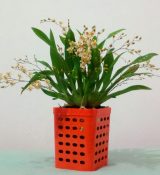Blooming Miltoniopsis (Miltonias) Orchids
Author: Celeste Booth1 Comment
Blooming, Care and Culture, Growing Indoors, Growing Outdoors

Information about specific blooming conditions of Miltoniopsis (Miltonias) orchid plants and flowers including ideal light and shade, temperature, humidity, air circulation, water, soil and planting beds, potting medium, feeding and fertilization.
- Light and Shade – Miltoniopsis grow well under a rather low amount of light (1500 – 2000 foot-candles). If grown in windowsills, it is recommended at either east or west exposure, or even south is tolerated if shielded from the sun. Fluorescent lights are an inexpensive way to supply light to Miltoniopsis too. These plants also enjoy being grown outside under shade if the temperature permits.
- Temperature – Miltoniopsis do well in the average home or intermediate temperature greenhouse. A night temperature between 55-65 degrees. and a daytime temperature between 70-80 degrees. works well. They will tolerate higher or lower temperatures, but not for extended periods of time.
- Watering – Miltoniopsis like to be kept fairly moist with a slight drying between watering. During warm dry weather, they may need to be watered 2-3 times a week, during cool weather 1-2 times a week. A sure sign of under watering would be the formation of wrinkled accordion-like pleated leaves. If this happens, increase your watering. However, this type of leaf wrinkle can also develop from over watering. Over watering causes the roots to rot, therefore depriving the plant from absorbing water because of the lack of roots. Remove the plant from the medium and check the roots if uncertain. Miltoniopsis have very tender and fragile roots. For this reason, we recommend using rain water whenever possible. Reverse osmosis systems are another way to filter your tap water and provide clean water for orchids.
- Humidity – If you keep your Miltoniopsis well watered, humidity is not a critical factor. However, Miltoniopsis thrive under high humidity so try to keep it above 50% if possible. Humidity trays or an ultra-sonic fogger can help increase humidity.
- Fertilizing – For tap or well water, fertilizer can be applied almost every watering during the spring and summer months. This should be reduced to once a week during fall and winter. We recommend a half strength solution of Grow More 20-10-20 fertilizer with each application. Another highly recommended fertilizer is Green Jungle Orchid Food, especially formulated to work with rain, distilled, reverse osmosis water or water low in alkalinity. Fertilize with Green Jungle every time you water, all year round.
- Potting – Miltoniopsis do well in a water retaining mixture. Small orchid bark mix, rock wool mix and New Zealand sphagnum moss mediums work well. It is important that the pot has adequate drainage. These plants like to be somewhat pot-bound so allow room for only one year’s growth. Repot once per each year, preferably in the spring.
Header photo via Wikimedia
One response on “Blooming Miltoniopsis (Miltonias) Orchids”
Leave a Reply


Ask an Expert
Questions about orchids?
Our experts love a challenge!
Photo of the Week
Submit your photo to be featured on the blog!
More Photo of the Week Winners
Submit Photo








I have just purchased a Milton orchid, not realizing it needed a specific spagnum moss of which I cannot purchase here in my city, however I do have a bit of spagnum here, will it do, it needs reporting, so can I use the one I have?